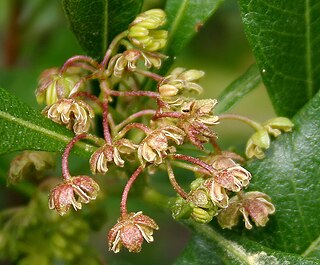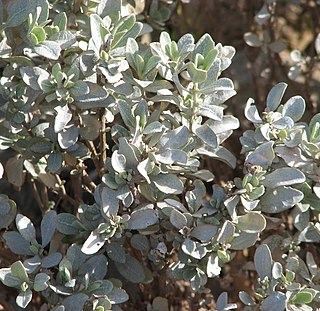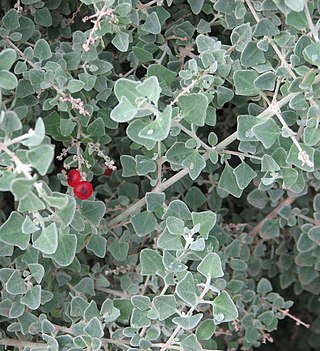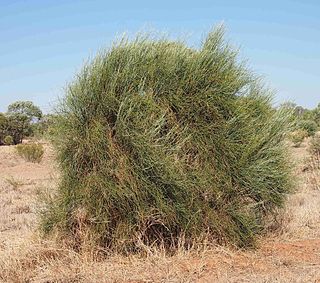
Acacia aneura, commonly known as mulga or true mulga, is a shrub or small tree native to arid outback areas of Australia. It is the dominant tree in the habitat to which it gives its name (mulga) that occurs across much of inland Australia. Specific regions have been designated the Western Australian mulga shrublands in Western Australia and Mulga Lands in Queensland.

Flindersia is a genus of 17 species of small to large trees in the family Rutaceae. They have simple or pinnate leaves, flowers arranged in panicles at or near the ends of branchlets and fruit that is a woody capsule containing winged seeds. They grow naturally in Australia, the Moluccas, New Guinea and New Caledonia.

Acacia ligulata is a species of Acacia, a dense shrub widespread in all states of mainland Australia. It is not considered rare or endangered. Its common names include sandhill wattle, umbrella bush, marpoo, dune wattle, small coobah, wirra, and watarrka.

Dodonaea viscosa, also known as the broadleaf hopbush, is a species of flowering plant in the Dodonaea (hopbush) genus that has a cosmopolitan distribution in tropical, subtropical and warm temperate regions of Africa, the Americas, southern Asia and Australasia. Dodonaea is part of Sapindaceae, the soapberry family.

Dodonaea is a genus of about 70 species of flowering plants, often known as hop-bushes, in the soapberry family, Sapindaceae. It has a cosmopolitan distribution in tropical, subtropical and warm temperate regions of Africa, the Americas, southern Asia and Australasia. By far the highest species diversity is in Australia. The genus is named after Rembert Dodoens, traditionally known as 'Dodonaeus'.

Atriplex vesicaria, commonly known as bladder saltbush, is a species of flowering plant of the family Amaranthaceae and is endemic to arid and semi-arid inland regions of Australia. It is an upright or sprawling shrub with scaly leaves and separate male and female plants, the fruit often with a bladder-like appendage.

Chenopodium curvispicatum is a species of plant in the family Amaranthaceae, endemic to Australia.
Granitites intangendus is a species of flowering plant endemic to Western Australia. It is found on granite outcrops in semi-arid regions of the midwest and south.

The Paroo-Darling National Park is a protected national park that is located in the Far West region of New South Wales, in eastern Australia. The 178,053-hectare (439,980-acre) national park spans two distinct regions in the outback area. This region covers the arid catchments of the Paroo River and the Paroo-Darling confluence to the south.

Dodonaea triquetra, known as common hop bush or large leaf hop bush, is a species of shrub occurring in eastern Australia.

Capparis anomala is a species of flowering plant, commonly called warrior bush or broom bush, which is native to Australia.
Dodonaea petiolaris is a shrub species in the genus Dodonaea found in Australia.

Feral goats are an invasive animal species in Australia. First arriving in the 18th century with European settlers, feral goat populations originated from escaped domestic individuals. Today, feral goats are found across Australia, where they cause economic and environmental damage through overgrazing and competition with livestock and native marsupials.

The Yathong Nature Reserve is a protected nature reserve that is also a nationally and internationally recognized biosphere situated in the central-western region of New South Wales, in eastern Australia. The 107,240-hectare (265,000-acre) reserve was listed by UNESCO in 1977 as a Biosphere Reserve under the Man and the Biosphere Programme (MAB). The reserve is significant for its biodiversity in both native plant and animal species. Cultural heritage and historical grazing activities add to the significance of this site as a conservation area.

Senna acclinis, commonly known as rainforest cassia or brush senna, is a species of flowering plant in the family Fabaceae and is endemic to near-coastal areas of eastern Australia. It is a shrub with pinnate leaves and bright golden yellow flowers in groups of two to five and long, narrow seed pods. It is similar to other species of Senna that are environmental weeds.

Dodonaea procumbens, commonly known as trailing hop bush or creeping hop-bush, is a species of shrub in the genus Dodonaea found in eastern Australia. It occurs in many places in Australia such as South Australia, New South Wales and Victoria. Although the information on the abundance of this species is limited, it is estimated that about 5,000 plants occur in about 55 wild populations. The species is currently facing many threats such as the expansion of road facilities, the development of residential and agricultural areas, increased grazing regimes, weed invasions, and regimes changing of fire. As a result, it is listed as vulnerable and threatened. Therefore, it is necessary to provide protective solutions for the long-term development and survival of this species.

Sclerolaena birchii, commonly known as galvanised burr, is a perennial shrub native to inland Australia.

Dodonaea subglandulifera, commonly known as Peep Hill hop-bush, is a species of plant in the family Sapindaceae and is endemic to South Australia. It is a small, upright shrub with flowers in small groups that are yellow-greenish to red-maroon.

Dodonaea stenozyga, commonly known as desert hop-bush, is a species of flowering plant in the family Sapindaceae and grows in southern parts of Australia. It is a small, upright shrub with small clusters of flowers and linear leaves.

Senna pleurocarpa, commonly known as fire bush or chocolate bush, is a species of flowering plant in the family Fabaceae and is endemic to Australia. It is a spreading shrub with pinnate leaves with five to seven pairs of broadly elliptic to egg-shaped leaflets, and groups of five to twelve yellow flowers arranged in dense groups of twenty to sixty on the ends of branches and in upper leaf axils.






















